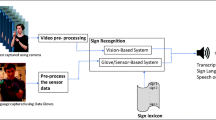Abstract
Sign language is a visual language. Research into Sign language, including in related areas such as linguistics and engineering is lagging behind spoken language. One reason for this is the absence of a common database available to researchers from different areas.
This paper defines how to words are selected for inclusion in the sign language database, how to select informants, what format the data are included in and how to record the data. Also, the database includes three-dimensional behavioral data based on dialogue. The following explains the results.
Access this chapter
Tax calculation will be finalised at checkout
Purchases are for personal use only
Similar content being viewed by others
References
Amano, S., Kasahara, K., Kondo, K. : NTT database series [Lexical Properties of Japanese] volume 9: word familiarity database (addition ed.). Sanseido Co., Inc, Tokyo (2008)
Corpus of Spontaneous Japanese. http://pj.ninjal.ac.jp/corpus_center/csj/. Accessed 29 Nov 2018
Katou, N.: NHK Japanese sign language corpus on NHK news. In: 2010 NLP (the Association for Natural Language Processing) Annual Meeting, pp. 494–497 (2010)
Japan Institute for Sign Language Studies (ed.).: Japanese/ Japanese Sign Language Dictionary. Japanese Federation of the Deaf, Tokyo (1997)
Nagashima, Y. : Constructing a Japanese sign language database and developing its viewer. In: Proceedings of the 12th ACM PETRA 2019, pp. 321–322 (2019). https://doi.org/10.1145/3316782.3322738
Acknowledgments
This work was supported by JSPS KAKENHI Grant Number 17H06114.
Author information
Authors and Affiliations
Corresponding author
Editor information
Editors and Affiliations
Rights and permissions
Copyright information
© 2020 Springer Nature Switzerland AG
About this paper
Cite this paper
Nagashima, Y., Watanabe, K., Hara, D., Horiuchi, Y., Sako, S., Ichikawa, A. (2020). Constructing a Highly Accurate Japanese Sign Language Motion Database Including Dialogue. In: Stephanidis, C., Antona, M. (eds) HCI International 2020 - Posters. HCII 2020. Communications in Computer and Information Science, vol 1226. Springer, Cham. https://doi.org/10.1007/978-3-030-50732-9_11
Download citation
DOI: https://doi.org/10.1007/978-3-030-50732-9_11
Published:
Publisher Name: Springer, Cham
Print ISBN: 978-3-030-50731-2
Online ISBN: 978-3-030-50732-9
eBook Packages: Computer ScienceComputer Science (R0)




